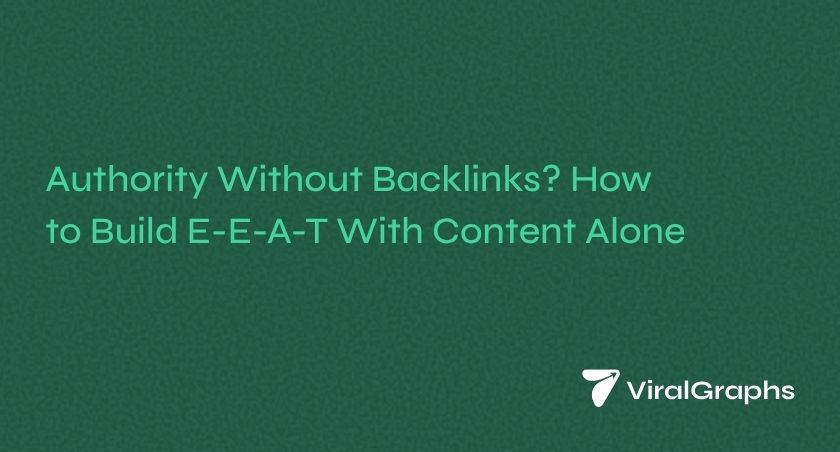For years, SEO advice revolved around one golden rule: get backlinks. More links = more authority = higher rankings. But in 2025, Google’s algorithms have evolved—and so must your content strategy.
While backlinks are still valuable, they’re no longer the only path to building trust and authority. Google’s increasing emphasis on E-E-A-T (Experience, Expertise, Authoritativeness, Trustworthiness) means content quality, not just link quantity, is now a central ranking factor.
So here’s the big question: Can you build online authority without backlinks?
Yes. And in this blog, we’ll show you exactly how to do it—step-by-step.
What Is E-E-A-T and Why It Replaced the Old Link Game
Let’s break it down:
- E = Experience
- E = Expertise
- A = Authoritativeness
- T = Trustworthiness
E-E-A-T is part of Google’s Search Quality Evaluator Guidelines, the internal standards used to assess whether a piece of content deserves to rank.
Why Is E-E-A-T More Important Than Ever?
- In the age of AI-generated content, Google needs new ways to detect real value.
- Users care more about authentic voices and accurate information.
- Google’s AI Overviews and snippets increasingly prioritize E-E-A-T-rich content.
Key Insight: Google’s 2025 updates expanded E-E-A-T signals to include on-page experience, author credibility, and first-hand evidence, even when there are no backlinks.
Why Backlinks Alone Won’t Build Authority in 2025
While high-quality backlinks still matter, relying solely on them creates a fragile SEO strategy. Here’s why:
- Backlink manipulation is easy to detect
Spammy or bought links can now be devalued or penalized faster than ever.
- Zero-click content is rising
Google’s AI overviews and snippets often credit content, not the domain’s link profile.
- E-E-A-T prioritizes creators, not just domains
You can now build page-level authority by showcasing the credibility of the individual behind the content.
- User signals matter more
Time on page, scroll depth, and interaction are now as valuable as domain authority metrics.
The 5 Pillars of Building E-E-A-T Without Backlinks
You don’t need thousands of backlinks to rank—you need trust, relevance, and value. Let’s dive into the key pillars that will help you build authority with content alone.
1. Showcasing Real-World Experience (The First “E”)
Google wants first-hand insights—not reworded summaries. You can establish this by:
How to Show Experience:
- Include personal anecdotes, case studies, or step-by-step breakdowns.
- Use phrases like “we tested…”, “our results showed…”, or “in my experience…”.
- Add original screenshots, performance graphs, or videos.
- Use author bios that highlight real-world credentials (not just job titles).
Pro Tip: For product reviews, tutorials, or opinion-based blogs, experience outweighs generic information.
2. Demonstrating Topical Expertise
Expertise is not about being famous—it’s about knowing your stuff and proving it clearly.
How to Prove Expertise:
- Assign content to people with real qualifications or deep knowledge in the topic.
- Add author bios, contributor pages, and links to published work or credentials.
- Reference relevant studies, reports, or statistics—then add your own insight.
- Include FAQs, glossaries, or deep dives that address specific subtopics.
- Avoid AI fluff—go deeper than surface-level content.
Expert Tip: Google tracks consistency of coverage. The more topic clusters you publish on one niche, the more trust you build.
3. Building Page-Level Authoritativeness
Authority used to be domain-driven. Now, each page can be authoritative in its own right.
How to Build Authority Without Links:
- Go deep: Publish long-form, well-structured content that exhausts a topic.
- Include interlinking to related internal content for semantic structure.
- Embed original data: surveys, quotes, proprietary insights.
- Use rich media (infographics, videos, calculators, or tools).
Example: A well-written, data-backed guide on “How to Build a No-Code App” can outrank a generic Forbes article with high DA but low E-E-A-T on the topic.
4. Enhancing Trustworthiness Through UX
Even great content fails when the experience is poor. Trust isn’t just what you say—it’s how your site feels.
UX Trust Signals That Improve E-E-A-T:
- Clear privacy policy and terms of use
- No intrusive popups or misleading CTAs
- HTTPS encryption (basic, but still matters)
- Clean, mobile-optimized design
- Author photos, timestamps, revision dates
- Transparent about monetization (affiliate disclosures, sponsored tags)
Did you know? Pages with clearly displayed credentials + last updated dates rank better in health, finance, and YMYL (Your Money Your Life) niches.
5. Creating Content That Drives Engagement (Behavioral Trust)
E-E-A-T isn’t just about content—it’s about how users interact with it. Google watches for:
- Click-through rates (from search results)
- Time on page
- Scroll depth
- Bounce rate
- Return visits
How to Increase Behavioral Trust:
- Use table of contents and jump links
- Start with an engaging hook or relatable pain point
- Add visuals every 250 words
- Break down long paragraphs
- Use bold, bullets, and structured formatting
- Ask questions and invite comments
Pro Tip: Add interactive elements like quizzes, polls, or calculators. They increase dwell time and engagement—critical E-E-A-T enhancers.
Case Study: Outranking High-DA Pages Without a Single Backlink
Website: bootstrappedmarketing.co
Topic: “How to Create a Marketing Plan for a SaaS Startup”
Competitors: HubSpot, Neil Patel, CoSchedule
Backlinks: Zero
What They Did:
- Used a real founder’s name with experience launching 3 SaaS tools
- Included screenshots from Notion docs and planning templates
- Shared actual marketing results from their launch
- Published a 3,200-word guide broken into digestible, jump-linked sections
- Answered “People Also Ask” questions natively
Result: Ranked on Page 1 in under 4 months, without a single backlink
Advanced Tactics to Boost E-E-A-T with Content Alone
Looking to go beyond the basics? Here are advanced moves:
Build Topical Authority Clusters
- Publish 5–10 articles around subtopics of a main niche.
- Interlink all of them internally.
- Google will treat your domain as a “hub” for that subject.
Add Structured Data (Schema)
Use schema markup to help search engines understand:
- Author credentials (Person schema)
- FAQs
- Reviews and ratings
- Medical or legal specialties (where relevant)
Use Original Data and Insights
Run a poll or collect industry data—even a small one. Publish findings as a blog or downloadable PDF.
Originality = Authority.
Show Off Author Expertise Visibly
- Link to social profiles or LinkedIn
- Include quotes or podcast clips
- Create a “Meet the Author” section at the bottom of key pages
Why This Framework Works Better Than Link-Building Alone
| Strategy | Pros | Cons |
| Backlinks | Fast authority boost if high-quality | Hard to earn organically, expensive, risk of penalty |
| E-E-A-T Content | Scalable, brand-safe, evergreen | Requires time, strategic planning, and consistency |
In 2025, link-building alone without strong E-E-A-T content won’t yield long-term success. But E-E-A-T content without backlinks can still win—especially in niche markets or when targeting featured snippets.
Checklist: Build E-E-A-T Without Backlinks
Here’s your go-to implementation list:
🔲 Use real authors with bios and experience
🔲 Add first-hand experience or original data
🔲 Link to reputable external sources
🔲 Optimize UX and site structure
🔲 Implement schema markup
🔲 Create topic clusters to build authority
🔲 Format for readability and engagement
🔲 Include timestamps, FAQs, jump links
🔲 Use multimedia: videos, infographics, tools
🔲 Track behavioral metrics (scroll depth, CTR, time on page)
Also Read: Dominate Google’s AI Overviews: 7 Proven Tactics to Rank #1
Final Thoughts: Authority Starts With Content—Not Links
In a post-backlink-dominant era, E-E-A-T is your most powerful SEO currency.
By focusing on real value, proven expertise, and excellent user experience, you can build authority, trust, and rankings organically—even with zero backlinks.
So next time someone says, “You need links to rank,” remember:
You need trust to rank.
And trust is built with content—first.









